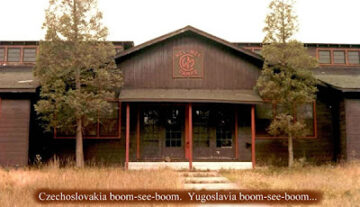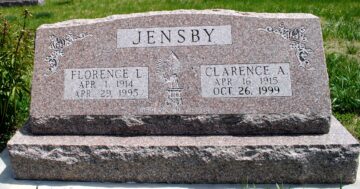by Barbara Fischkin
The place where I learned the most about diversity, equity and inclusion was not at my liberal summer camp in New York’s Catskills mountains—but at a pig farm in northern Kansas. To be fair, if it wasn’t for camp, I never would have pitched a tent under the big sky of the Jensby farm.

I was there because, as my last chapter noted, Wel-Met, my summer sleep away camp, had a free-range philosophy. Campers planned their own activities, hiked into the woods for sleepovers and—when older—lived in tents rather than bunks. This was a preparation for the next step: Cross-country camping trips. Wel-Met ran six of these each summer and in the 1960s they all stopped at the farm of Clarence and Florence Jensby. The Jensbys welcomed all with open arms—campers and returning counselors alike. (I arrived three times). On the surface, we could not have been more different. Or in today’s lingo, more diverse. Most of us were Jewish New Yorkers. The Jensbys were Christian midwesterners.
It did not matter. With great panache, the Jensbys introduced us to their operation and their pigs who, well, smelled like pigs. This came as a surprise to the city slickers. Mrs. Jensby demonstrated, with schoolteacher-like skills, how to prepare a live chicken for dinner. Trip after trip, year after year, she showed city kids how she would break the chicken’s neck, pluck the feathers, yank out the guts and prepare it for cooking. Some campers were horrified. I saw her humanity. I saw her as a farmer who worked quickly to minimize suffering. Today, when I view pictures of chickens raised in crowded coops, not free-range—or hormone or antibiotic free—I think of how Mrs. Jensby did it better.
I also have a memory of Mrs. Jensby dressed up, wearing her good shoes and leaving the farm—perhaps for church. I wondered how she did this without stepping on any animal droppings. I wondered how she had transformed herself so quickly from farm wife in a blood-stained apron to a “proper” lady. A lifelong lesson: there is more to a person than you see at first.
Logic suggests that free-range should lead to freedom. And in turn, people who feel free are able to accept diversity, equity and inclusion. These days those three words—diversity, equity and inclusion, are very much in the news. They are known, less elegantly, as DEI. Last week Donald Trump, in a speech that was cruel, clumsy and inaccurate, blamed DEI for the worst fatal American plane crash in decades. The crash was caused by a staff shortage and human error. Most certainly not DEI. Shocking as Trump’s assessment was it was also in character – take credit when possible, deserved or not; find someone to blame, regardless of truth when things go bad. When most of us encounter a sad situation not of our doing, we express regret.
The Truth: Nothing about DEI is this simple.
Reflecting on my childhood and teenage years at camp, I see inconsistencies. Even that camp run by lefty social workers had lapses in diversity, equity and inclusion.
Most campers were, indeed, white and Jewish, although not Orthodox. There were those few campers of color, mentioned briefly in part one of my camp memories. Included among the black campers were a brother and sister with Albinism, a condition that could have made them dual-targets in any number of settings. Primarily in other countries, people with Albinism have been the targets of stigma and superstition. They have been hunted for body parts said to bring good luck. At Wel-Met those kids with Albinism were just dropped in among us. I was a child then, too. I had never seen anyone who looked the way they did and I was curious. I didn’t dwell on it, and don’t remember that anyone else did. I could be wrong, but that brother and sister did not look happy to me. They looked like people who felt they did not belong.
There was also a counselor who was a small person. I believe he went on to become an actor —and he always looked joyous. That was all I knew about him.
I don’t remember anyone else at the camp with a disability, even a mild one. This could have been due to many reasons, including a reluctance by parents to send children to camp where they might not have been understood or cared for properly. Also, in those years, lots of kids were often institutionalized even when it wasn’t necessary.
There was also a little boy, the son of a camp director, who may have been too young to participate in camp activities. I will never forget him. I worked one summer as this little boy’s babysitter. He was adorable with red hair and freckles but he hardly spoke and could also be violent. He liked to throw rocks. As the mother of an adult son with non-speaking autism, I now understand the frustrations that led this little boy to misbehave. Back then, I did a terrible job. I was a teenager with no idea what to make of him. Nor, it seemed, did most others at camp. Often when they saw me having a hard time, they looked away. “Better you than me.”
As for those cross-country trips, along with the Jensbys and hiking the Grand Canyon, learning about Native American history was a high point. But that too had its lapses. We stopped at Mesa Verde National Park in Colorado and climbed its ancestral Puebloan cliff dwellings. Then we bought turquoise jewelry. If we ever had an educational or historical lesson from a Native American on tribal history or culture, I don’t remember it.

Recently I searched the Internet for stories about the Jensbys. I found that like so many Americans—and so many New Yorkers—they were descended from immigrants. So maybe we all had more in common than I knew. In the 1800s, their ancestors arrived in the United States from Denmark—and suffered hardships in the process.
I am grateful to a close relative of the Jensbys, Kent Jensby, who wrote this illuminating comment, in response to a blogger’s memory of the farm. It is dated July 3, 2010. “Mike” is the blogger. Kent Jensby wrote:
“Mike, you must be one of the ‘New Yorkers’ that came out each year on a bus and stayed with Uncle Clarence and Aunt Florence. Clarence and my Grandfather were brothers and my Grandpa lived just down the road from where you stayed, I grew up on a farm about 8 miles north just into Nebraska and my folks, each summer, would take us to visit when the ‘New Yorkers’ were back. We would get a kick out of watching all of you play in the corn bin and paddle boat and fish in the ponds or just do or be a part of things ‘we as farm kids’ did every day.
Here’s a little bit of our family history for you, all Jensbys in the United States are from one family which started with my Great Grandfather, Anton Jensby. Anton came from Denmark in the middle 1800’s with another brother who died in his late teens and a sister who married but never had children. Anton’s parents sent them on one ship with intentions of coming on the next ship. Unfortunately they were killed when the ship they were on sank. Anton was the oldest at only 15 years old. He ended up settling in this area about the time of Nebraska’s statehood and became a large farmer and cattle feeder. The land he settled on has never been in any name outside the Jensby family and is still in the Jensby family. I am in the process of buying it because I have a son (now 19 years old) to pass it on to. Now I can only hope he too has a son someday in order to keep the name alive. Where there are so few of us, the birth of a Jensby boy to carry on the name is cause for a family celebration! Anton married and raised 5 sons and 2 daughters. Two of those sons were Uncle Clarence and my Grandpa Leslie, all but one son stayed in this area and became farmers. I don’t farm however several members of the Jensby family are still in the area and continue to farm and ranch. Clarence has a son Jim Jensby; he and his wife June live in the area of Belleville Kansas.
I hope this was helpful information, if I can answer any specific questions you might have please feel free to contact me.
Thanks,
Kent Jensby
If I ever knew how Wel-Met connected with the Jensbys, this information escapes me now. All I know for sure is that I am happy Anton made it to America. I hope he enjoyed our diversity, equity and inclusion. It seems like he did.
